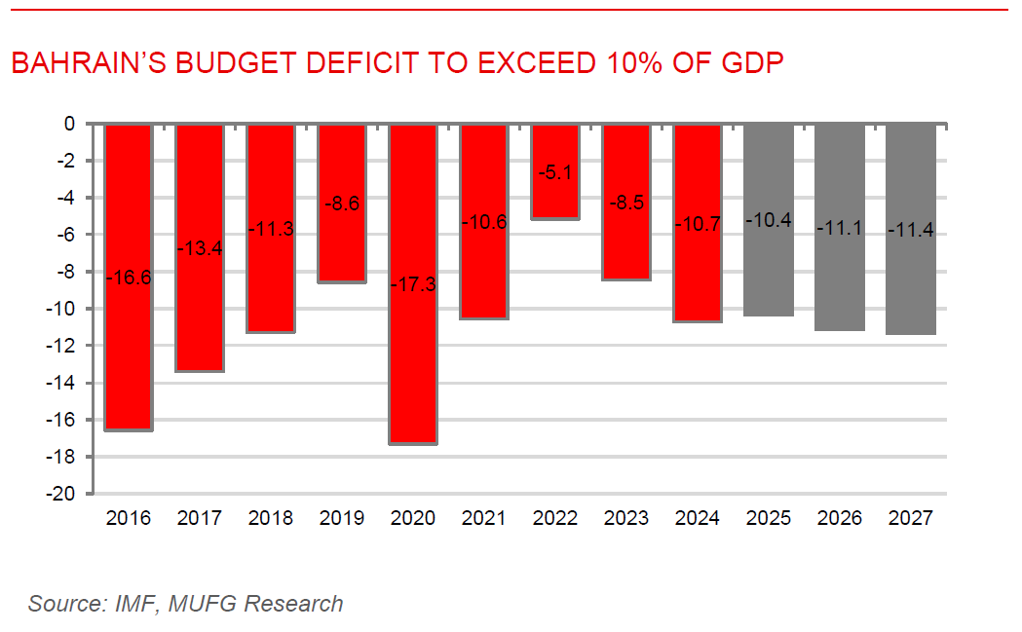To read the full report, please download the PDF above.
Middle East Daily
SOOJIN KIM
Research Analyst
DIFC Branch – Dubai
T: +44(4)387 5031
E: soojin.kim@ae.mufg.jp
MUFG Bank, Ltd. and MUFG Securities plc
A member of MUFG, a global financial group
Middle East Daily
COMMODITIES / ENERGY
Oil firms ahead of OPEC+ meeting despite glut concerns. Oil prices edged higher today after a sharp three-day slide of nearly 7%, with Brent near USD66/b and WTI above USD62/b, as markets awaited the weekend OPEC+ meeting, where producers are expected to agree on another output hike for November despite concerns over a looming glut. US data showed crude inventories rose for the first time in three weeks and gasoline stocks jumped the most since June, while refinery runs fell on maintenance. Adding to supply pressures, Iraq’s Kurdish crude exports via Turkey’s Ceyhan terminal are set to resume for the first time since 2023. Meanwhile, the G-7 is preparing tougher sanctions on Russia, targeting energy, finance, and defence sectors, while also weighing restrictions on countries and entities helping Russia bypass existing curbs.
Gold holds near record as US shutdown fuels Fed cut bets. Gold steadied around USD3,860/oz after a five-day rally that pushed it to successive records, as the start of a US government shutdown delayed key economic data and heightened uncertainty over the Fed’s policy path. With official payroll figures postponed, traders leaned on private-sector data showing a steep drop in employment and added to bets that the Fed will deliver two more rate cuts this year to cushion a weakening labour market. Lower rates and a softer dollar typically boost gold, which has already surged 47% in 2025, its strongest run since 1979, supported by central bank purchases and inflows into gold-backed ETFs, which saw their largest monthly gain in three years in September. Demand has also been reinforced by Chinese fund buying and haven flows, with concerns over Fed independence intensifying after the Supreme Court blocked President Trump’s immediate attempt to remove Governor Lisa Cook.
MIDDLE EAST - CREDIT TRADING
End of day comment – 01 October 2025. Mixed day. The morning had sellers and was weak , spreads widened significantly post ADP numbers and the UST rally, the move lower in yields failed to lure buyers. The last two hours of the day though with macro market strength saw buyers coming in and with UST coming off spread moves normalised to closing 2/3bp wider on average. Flows and market positioning is still such that long end bonds remain in demand, see for example MUBAUH being bid up again in duration bonds, 51s closing +0.25pt/-4bp. But equally 5-10y bonds remained offered, especially the 5y area in Quasi sovereign bonds, ADQABU 30s closing -0.125pt/+5bp. New KUWIB issues weighed a bit on recent ADGB issues, especially the 3y is struggling and closed at T+25bp which is now 15bp wider from reoffer level. On the back of it there were sellers of 5y old bonds like ADGB 1.7% 31s closing -0.125pt/+5bp. Higher beta names were a mixed bag, MOROC was 0.125/0.25pt lower and 2/4bp wider but OMAN curve stabilised closing broadly unch in spread terms. Overall the market feels weaker than price and spread moves suggest. Dealers are still trying to cut positions in the belly and there is still the expectations of more new issuance which coming in the 5/10y area. That benefits the only real area of strength which are long end bonds. Expect credit curves to flatten more.
MIDDLE EAST - MACRO / MARKETS
2025 MENA Playbook: Resilient wealth amid regional turmoil. Global SWF’s recent report highlighted the MENA’s sovereign wealth landscape amid persistent conflict yet strong economic dynamism. The Gulf remains the region’s wealthiest block, still dependent on oil revenues, but actively pursuing diversification and foreign investment. Sovereign wealth funds (SWFs) dominate with USD5.6 trillion in assets, projected to reach USD8.8 trillion by 2030, while central banks and pension funds expand reserves and contributions. GCC investors continue to drive global dealmaking, accounting for 40% of worldwide state-owned investment activity in 2025, with strong flows into the US, Europe, and Asia. Despite limited inbound capital, Gulf states are attracting international asset managers and building cross-border ties, particularly with Asia. The report also details evolving tax and pension reforms, the role of Islamic Finance, and Abu Dhabi’s emergence as the “capital of capital”.
Bahrain raised USD2.5bn in bond sale amid mounting fiscal pressure. Bahrain raised USD2.5bn through a dual-tranche bond sale, comprising a USD1.5bn sukuk due 2034 at 5.875% and a USD1bn 12-year note at 6.625%, attracting peak orders of about USD8.5bn. The issuance highlights strong investor demand for the region’s higher yields as US rates decline, following similar sales from Kuwait and Egypt. Despite this appetite, Bahrain remains rated junk by major agencies, with Fitch recently shifting its outlook to negative due to high debt and persistent deficits. The IMF forecasts Bahrain’s economy to expand 2.8% in 2025, but with budget deficit exceeding 10% of GDP and a fiscal breakeven oil price at USD137/b, the highest in the Gulf. Previous fiscal reform efforts faltered post-COVID, leaving the kingdom reliant on heavy borrowing and continued support from wealthier neighbours like KSA.

